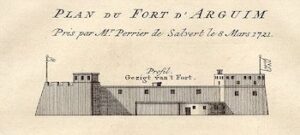
The Fort of Arguin
*The Fort of Arguin is celebrated on this date in 1443. This was a slave fort island off the western coast of Mauritania in the Bay of Arguin.
The first European to visit the island was the Portuguese explorer Nuno Tristão. In 1445, Prince Henry the Navigator set up a trading post on the island, which acquired gum Arabic and enslaved people for Portugal. By 1455, 800 slaves were shipped from Arguin to Portugal every year. The island changed hands frequently during the colonial era.
In 1633, during its Dutch-Portuguese War, the Netherlands seized control of Arguin. It remained under Dutch rule until 1678, briefly interrupted by English rule in 1665. France took over the island in September 1678, and was abandoned until 1685. Arguin's climate dryness and lack of a good anchorage made long-term European settlement difficult. It is approximately 6 km × 2 km (3.7 mi × 1.2 mi) in size, with extensive and dangerous reefs around it. In 1685, Captain Cornelius Reers occupied the old Portuguese fort and successfully established a treaty with the African king in which Brandenburg was a protecting power. The treaty was ratified in 1687 and was renewed in 1698.
Arguin remained a colony of Brandenburg until 1721 when the French successfully assaulted the fort and took control of the island. The Dutch took the fort and island from the French the following year, only to lose it again in 1724 to the French. This period of French rule lasted four years; in 1728, it reverted to indigenous peoples' control. In July 1816, the French frigate Méduse, bound for Senegal, was wrecked off Arguin, and 350 people died. The island was included in the territory of the French colony of Mauritania, and it remained under Mauritanian rule when that country became independent in 1960. The island is now part of the Banc d'Arguin National Park.